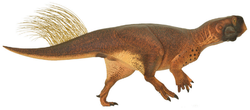| Gryphoceratops Temporal range: Late Cretaceous, | |
|---|---|
 | |
| Life reconstruction | |
| Scientific classification | |
| Domain: | Eukaryota |
| Kingdom: | Animalia |
| Phylum: | Chordata |
| Clade: | Dinosauria |
| Clade: | † Ornithischia |
| Family: | † Leptoceratopsidae |
| Genus: | † Gryphoceratops Ryan et al., 2012 |
| Species: | †G. morrisoni |
| Binomial name | |
| †Gryphoceratops morrisoni Ryan et al., 2012 | |
Gryphoceratops is an extinct genus of leptoceratopsid ceratopsian dinosaur known from the Late Cretaceous of Alberta, southern Canada. [1]



